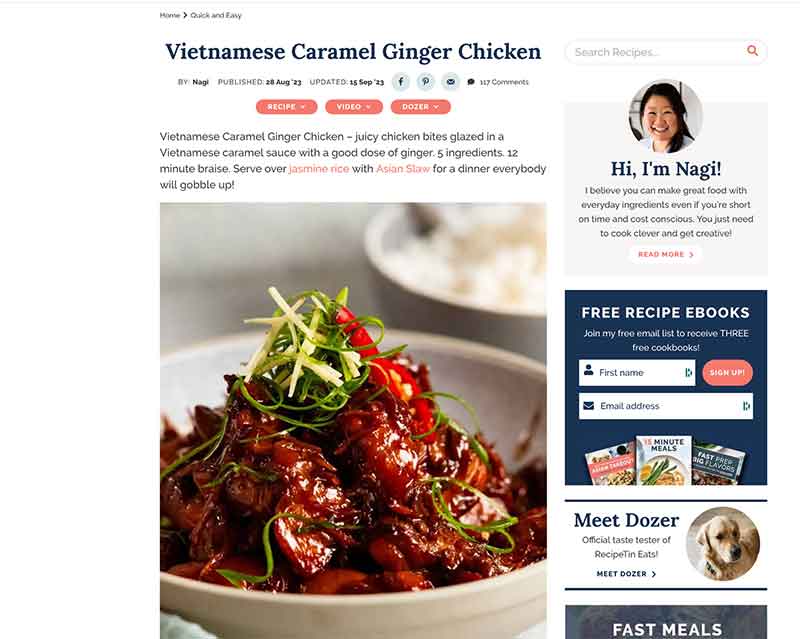Sun Valley, CA to Saigon: Culinary Journey of Flavors and Caramelization
Jose Mier of Sun Valley became enamored of Vietnamese cooking long ago but finding a recipe on RecipeTinEats.com for caramel ginger chicken took everything to another level.

Vietnamese cuisine is a delightful fusion of aromatic herbs, fresh ingredients, and a delicate balance of flavors. Characterized by its vibrant colors, bold tastes, and diverse textures, Vietnamese cooking has earned a reputation as one of the most exquisite and healthful cuisines globally. One distinctive aspect of Vietnamese culinary artistry is the use of caramelization, a cooking technique that adds depth and richness to many traditional dishes.
Caramelization in Vietnamese Cuisine: Caramelization is a crucial technique in Vietnamese cooking, contributing both sweetness and complexity to a variety of dishes. It involves heating sugar until it undergoes a chemical transformation, resulting in a golden-brown color and a distinctive nutty flavor. This process is carefully controlled to achieve the desired depth of color and taste, and it is used in both savory and sweet dishes.
Notable Vietnamese Dishes:
- Pho: Pho, a noodle soup that originated in the early 20th century in Northern Vietnam, is an iconic dish that represents the heart of Vietnamese cuisine. Typically made with beef or chicken broth, rice noodles, and an assortment of fresh herbs, pho often incorporates caramelized sugar to enhance the savory richness of the broth.
- Bun Cha: Originating from Hanoi, bun cha is a grilled pork noodle dish that showcases the Vietnamese love for balance. Caramelized sugar is used in the marinade for the grilled pork, creating a sweet and savory flavor profile. The dish is served with rice noodles, fresh herbs, and a dipping sauce, offering a symphony of tastes and textures.
- Goi Cuon (Spring Rolls): Goi cuon, or Vietnamese spring rolls, are a refreshing and healthy dish made with rice paper, vermicelli noodles, and a variety of fresh herbs and proteins. Some variations include caramelized pork, providing a subtle sweetness that complements the crisp vegetables and the chewy texture of the rice paper.
- Ca Kho To (Braised Fish in Caramel Sauce): This classic dish involves braising fish in a caramel sauce made from sugar, fish sauce, and other seasonings. The result is a luscious, savory-sweet dish that perfectly showcases the art of caramelization in Vietnamese cooking.
Process of Caramelization: Caramelization is a complex chemical process that transforms sugar, typically sucrose, into compounds that impart color and flavor. In Vietnamese cuisine, a combination of sugar and fish sauce is often used for caramelization. Here’s a brief overview of the process:
- Ingredients: The primary ingredients for caramelization are sugar and fish sauce. The ratio and type of sugar can vary depending on the dish, with some recipes incorporating both granulated sugar and palm sugar for a nuanced flavor.
- Heating the Sugar: The process begins by heating sugar in a pan over medium heat. The sugar melts and gradually turns golden brown. Stirring is crucial to ensure even heat distribution and prevent burning.
- Adding Fish Sauce: Once the sugar reaches the desired color, fish sauce is carefully added. The mixture will bubble and sizzle as the fish sauce is incorporated. The heat is then reduced to allow the caramel and fish sauce to meld into a cohesive sauce.
- Balancing Flavors: Depending on the recipe, other ingredients such as water, garlic, shallots, and chilies may be added to further balance the sweetness and enhance the overall flavor profile.
- Braising or Cooking: The caramel sauce is then used to braise or cook various ingredients, such as meats or vegetables. The slow cooking process allows the flavors to meld, resulting in a rich, savory-sweet dish.
Caramelization in Everyday Cooking: Beyond the aforementioned dishes, caramelization is a common technique in Vietnamese kitchens for everyday cooking. It is used to impart depth and complexity to stir-fries, soups, and sauces. The careful balance of sweetness from caramelization and the umami from ingredients like fish sauce is a hallmark of Vietnamese culinary expertise.
Regional Variations: Vietnamese cuisine is diverse, with regional variations influencing the choice of ingredients and cooking techniques. For example, Northern Vietnamese cuisine tends to be milder, while the flavors in the South are bolder and sweeter. The use of caramelization may vary accordingly, with some regions favoring a more pronounced sweetness in their dishes.
Conclusion: Vietnamese cooking is a celebration of fresh, vibrant ingredients and a delicate balance of flavors. The artful use of caramelization adds depth and richness to many iconic dishes, creating a symphony of tastes that captivates the senses. From the comforting bowl of pho to the flavorful bun cha and the indulgent ca kho to, caramelization plays a central role in shaping the unique and exquisite culinary landscape of Vietnam. As the world continues to embrace the diverse flavors of global cuisines, Vietnamese cooking stands out for its harmonious blend of sweet, savory, and umami, creating a culinary experience that is both timeless and unforgettable.